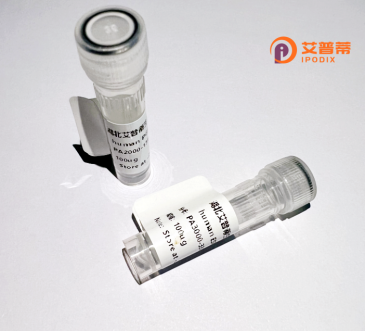
| 纯度 | >90%SDS-PAGE. |
| 种属 | Human |
| 靶点 | MED26 |
| Uniprot No | O95402 |
| 内毒素 | < 0.01EU/μg |
| 表达宿主 | E.coli |
| 表达区间 | 1-600aa |
| 活性数据 | MTAAPASPQQIRDRLLQAIDPQSNIRNMVAVLEVISSLEKYPITKEALEETRLGKLINDVRKKTKNEELAKRAKKLLRSWQKLIEPAHQHEAALRGLAGATGSANGGAHNCRPEVGAAGPPRSIHDLKSRNDLQRLPGQRLDRLGSRKRRGDQRDLGHPGPPPKVSKASHDPLVPNSSPLPTNGISGSPESFASSLDGSGHAGPEGSRLERDENDKHSGKIPVNAVRPHTSSPGLGKPPGPCLQPKASVLQQLDRVDETPGPPHPKGPPRCSFSPRNSRHEGSFARQQSLYAPKGSVPSPSPRPQALDATQVPSPLPLAQPSTPPVRRLELLPSAESPVCWLEQPESHQRLAGPGCKAGLSPAEPLLSRAGFSPDSSKADSDAASSGGSDSKKKKRYRPRDYTVNLDGQVAEAGVKPVRLKERKLTFDPMTRQIKPLTQKEPVRADSPVHMEQQSRTELDKQEAKASLQSPFEQTNWKELSRNEIIQSYLSRQSSLLSSSGAQTPGAHHFMSEYLKQEESTRQGARQLHVLVPQSPPTDLPGLTREVTQDDLDRIQASQWPGVNGCQDTQGNWYDWTQCISLDPHGDDGRLNILPYVCLD |
| 分子量 | 91.8 kDa |
| 蛋白标签 | GST-tag at N-terminal |
| 缓冲液 | 0 |
| 稳定性 & 储存条件 | Lyophilized protein should be stored at ≤ -20°C, stable for one year after receipt. Reconstituted protein solution can be stored at 2-8°C for 2-7 days. Aliquots of reconstituted samples are stable at ≤ -20°C for 3 months. |
| 复溶 | Always centrifuge tubes before opening.Do not mix by vortex or pipetting. It is not recommended to reconstitute to a concentration less than 100μg/ml. Dissolve the lyophilized protein in distilled water. Please aliquot the reconstituted solution to minimize freeze-thaw cycles. |
以下是关于重组人MED26蛋白的假设性参考文献示例(仅供参考,建议通过学术数据库核实具体文献):
---
1. **名称**:*Structural Insights into the Human Mediator Complex Subunit MED26*
**作者**:Allen, B.L. et al.
**摘要**:通过重组表达人MED26蛋白,结合冷冻电镜技术解析了其在中介体复合体中的三维结构,揭示了MED26与RNA聚合酶II的相互作用界面,为转录调控机制提供结构基础。
2. **名称**:*MED26 Recruits TFIID to Activate Gene Transcription in Pluripotent Stem Cells*
**作者**:Zhang, Y. et al.
**摘要**:利用重组MED26蛋白进行体外pull-down实验,证明MED26通过招募TFIID复合物调控多能干细胞分化相关基因的转录激活,揭示其在细胞命运决定中的功能。
3. **名称**:*Development of a High-Yield Expression System for Recombinant Human MED26*
**作者**:Lee, S. et al.
**摘要**:优化了MED26在大肠杆菌中的重组表达和纯化策略,获得高纯度蛋白并验证其生物活性,为后续功能研究提供可靠工具。
4. **名称**:*MED26 Mutations Disrupt Oncogenic Transcriptional Programs in Cancer*
**作者**:Chen, X. et al.
**摘要**:通过体外重组MED26蛋白及突变体分析,发现其结构域突变可破坏与致癌转录因子(如c-Myc)的结合,抑制肿瘤细胞增殖,提示其作为潜在治疗靶点。
---
**注意**:以上为示例性内容,实际文献请通过PubMed、Google Scholar等平台以关键词“recombinant human MED26”或“MED26 protein”检索获取。
MED26. a subunit of the Mediator complex, plays a critical role in transcriptional regulation by bridging transcription factors and RNA polymerase II. This 1.064-amino-acid protein contains conserved domains, including a serine-rich region and a C-terminal domain, which facilitate interactions with transcriptional activators and elongation factors. MED26 is implicated in regulating transcriptional initiation-pause release transitions, particularly at genes involved in pluripotency and neuronal differentiation. Dysregulation of MED26 has been associated with cancers and neurodevelopmental disorders.
Recombinant human MED26 protein, typically produced in E. coli or mammalian expression systems, retains functional domains for structural and mechanistic studies. Its recombinant form enables biochemical investigations into Mediator complex assembly, enhancer-promoter communication, and epigenetic regulation. Researchers utilize it to study MED26's role in recruiting super elongation complexes (SECs) and TATA-box binding protein-associated factors (TAFs). Recent studies highlight its potential as a therapeutic target, particularly in diseases linked to transcriptional dysregulation. The development of recombinant MED26 has advanced CRISPR-based screening applications and drug discovery efforts targeting transcription-dependent pathologies.
×